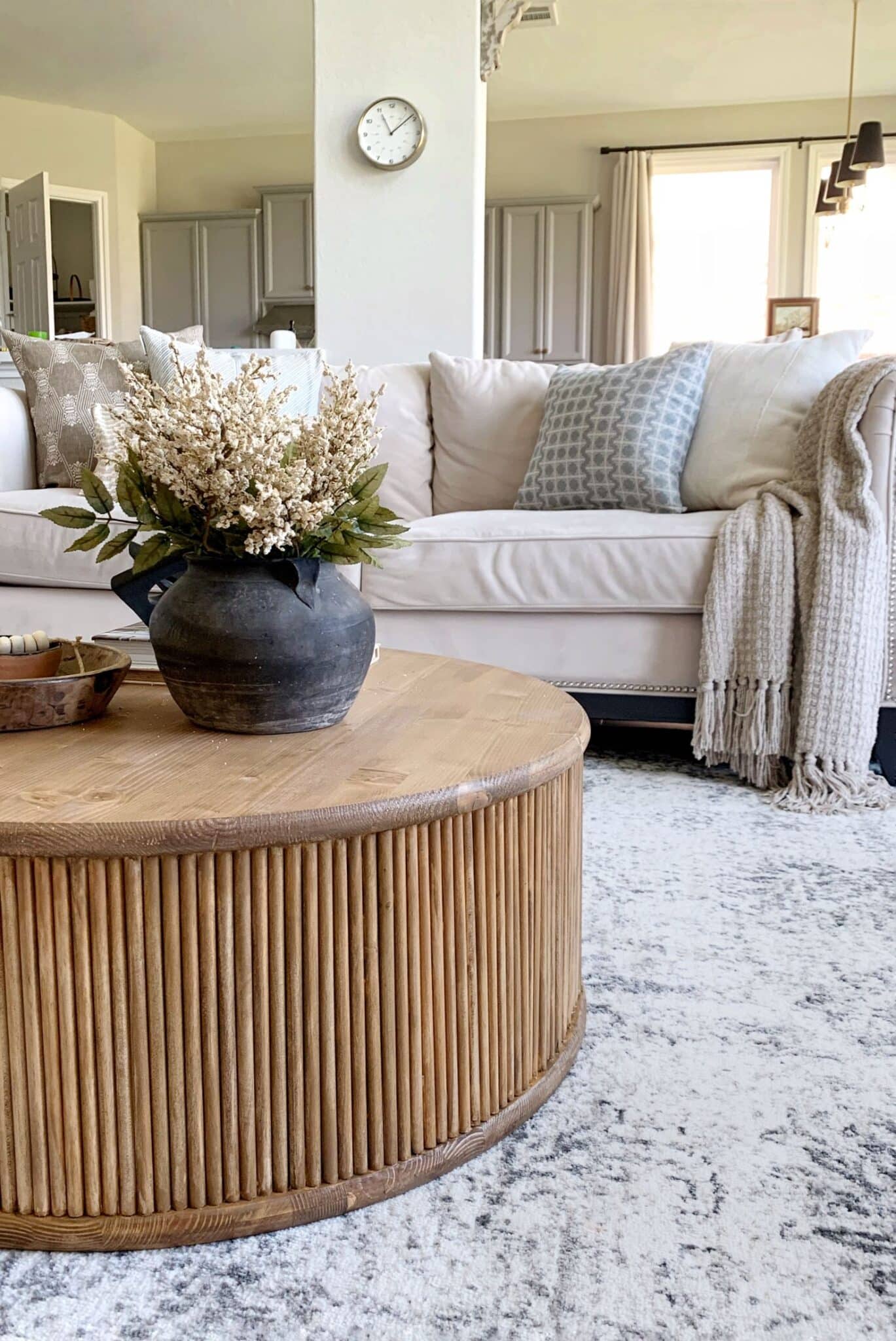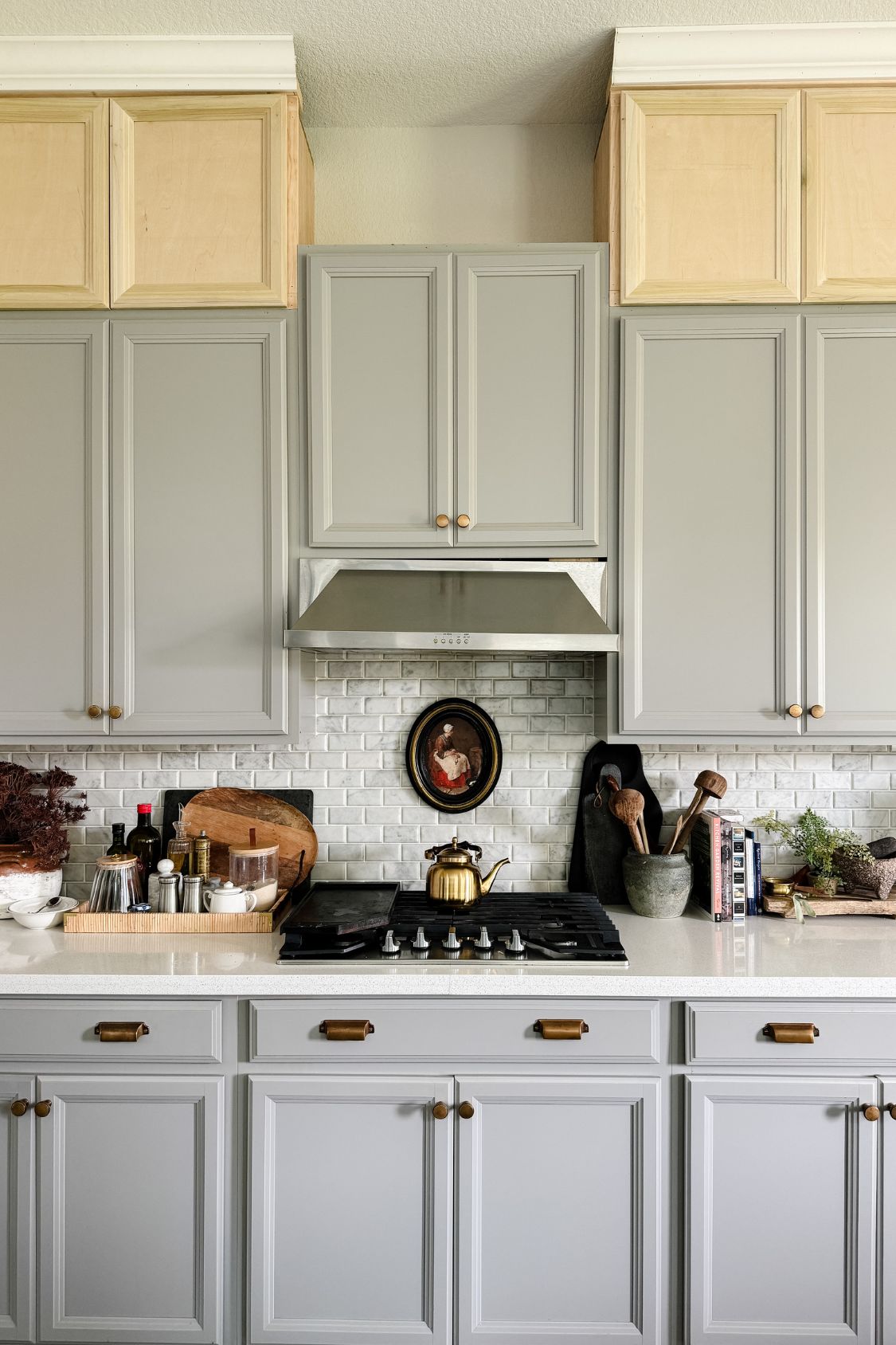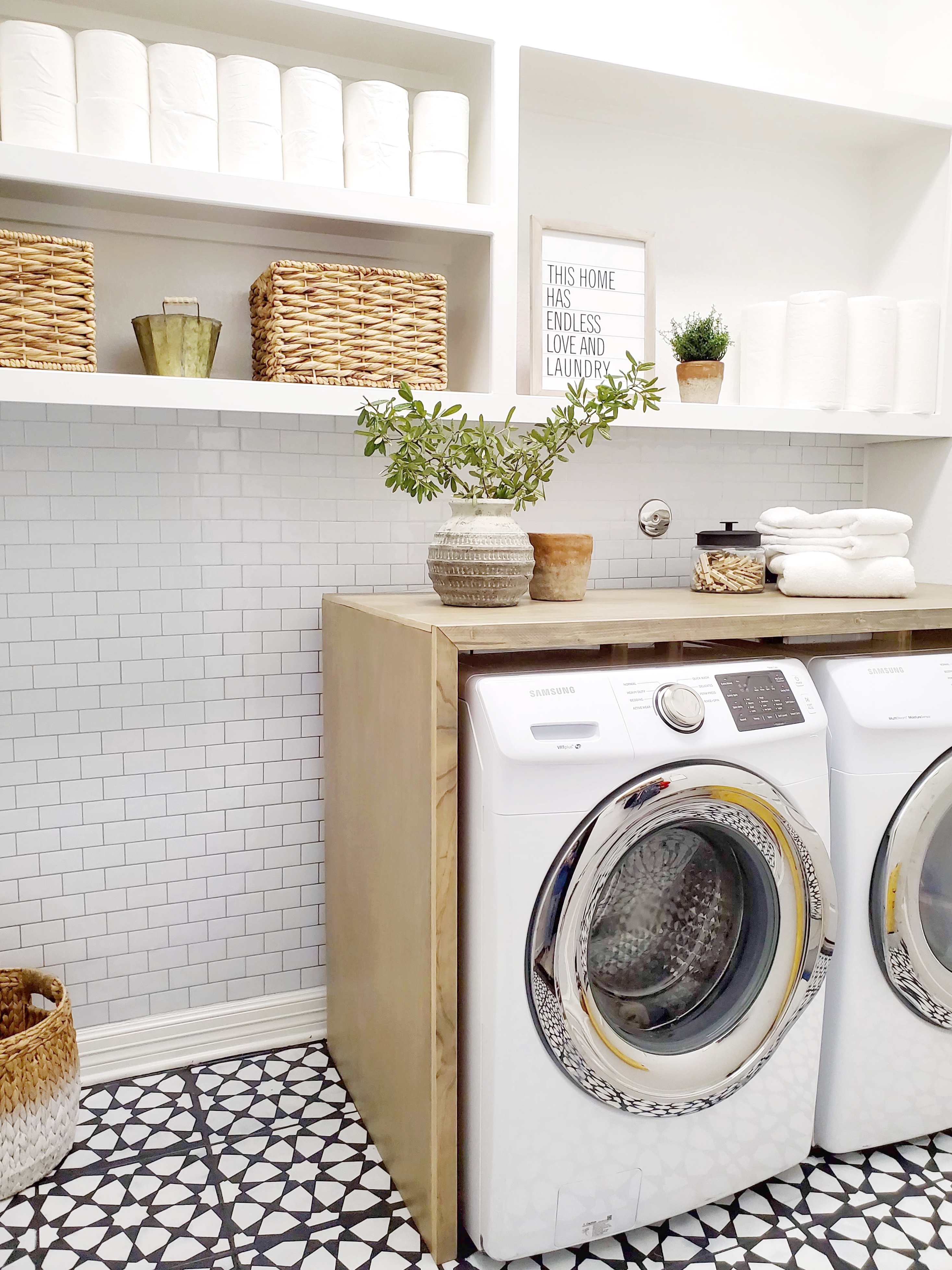DIY Carpet Runner on Stairs: A Step-by-Step Tutorial

A carpet runner on stairs always adds a touch of elegance to any home. I added my own DIY stair runner to my formerly carpeted stairs and it has made such a big impact! If this is your first time installing a runner to your hardwood staircase, I’m sharing how I did this easy DIY project with a unique look. This step-by-step guide will show you how I got the look of vintage beautiful stair runners by mixing three new runner rugs.
Here’s a little back story to this staircase runner project. I hated the look of my builder grade carpeted stairs and one fine day, I just cut out a piece of the old carpet from the top of the stairs. There was no looking back after that, I had embarked on the surprise mission of refinishing my carpeted stairs. I turned my main staircase from a boring carpet to beautiful painted black stairs. Before you run to Home Depot, read all about that tutorial here:
Finding the Perfect Runner Rug

My plan from the beginning was to install a runner on my freshly refinished stairs and I had a vision in mind. My vision was of a vintage stair runner like the one in Hilary Duff’s home that was published in Better Homes and Gardens. I was obsessed with the lived-in look of this vintage runner and wanted the same for my stairs. After doing some research I found out that it was actually three different vintage rugs that were cut down and tailored into one seamless staircase runner. I just had to find the right colors for my living room, and find the perfect vintage rugs to complete this old house look.
And that, my friends, is where the trouble started. I looked high and low for the perfect sized vintage runner rugs to fit my staircase and obviously they are all unique so I’d have to find a few designs that would work together AND be the exact same width. I spent a ton of time on Etsy and even asked a friend who sources vintage rugs to help, but everything I found was either too expensive for my budget or just didn’t work in terms of measurements.
I then had an idea to look into Synthetic fiber printed rugs. These printed rugs come in vintage inspired patterns and I would get the look without the difficulty and price tag of sourcing an actual vintage rug. Loloi Rugs to the rescue! I ordered a bunch of samples and put them next to each other to see what worked together in a flow. I finally picked these three beautiful runners for my own mix and match staircase runner look:
 |
 |
 |
Materials and Tools needed
- Narrow Crown Staple Gun
- Narrow Crown Staples
- Carpet Seam Sealer
- Carpet Seam Tape
- Double-Sided Carpet Tape
- Tape Measure
- Painter’s Tape
- Utility Knife or Sharp Scissors
- Runner or multiple runners of your choice
Stair Runner Installation Guide
Step 1: Measure the Stairs
Before you purchase your runners, the first thing you need to do is measure your staircase! Grab your tape measure and start at the base of the riser on the bottom of the stairs. The best way is to use a flexible tape measure but I didn’t have one and used my regular tape measure. Measure the height of the riser and add a couple inches for the nose of the stair. Next, measure the stair tread and add those two measurements together.
Multiply that measurement by the number of stairs you have to find out the total length of the new stair runner. I highly recommend ordering extra because there’s no simple method of calculating the landing area. You will be making cuts here to align the pattern together so it won’t be one single piece of runner.
Step 2: Mark the Runner Placement

Some prep work: The first step after your runners arrive is to mark the runner placement on the entire staircase. Measure the width of the stair tread, subtract the width of the rug and divide that number by 2. This will give you the exact measurement you should have on the side of the runner. For example, I have 5″ on either side of the runner. My runner’s width is 27.5″ and the staircase width is 37.5″.
Now take your painter’s tape and place it on each step to mark where the runner should hit. This will be a helpful guide when you’re actually nailing the runner in. Trust me, it’s not so simple to keep the runner centered! You will need all the markers to keep it nice and straight.
Step 3: Installing the DIY Stair Runner

- Cut strips of double sided rug tape and add two to each tread. This will help keep the runner in place as you staple it in.
- Start from the base of the stairs and make your way up, it’s easier this way. Take the first runner and align it with the painters tape you used earlier. Next, use your narrow crown stapler to staple the runner to the base of the riser. If your staples are too visible on the runner you could take a black sharpie and color them in to hide them better if you have black stripes. However, with my rug pattern they were virtually invisible! You could also use a pneumatic stapler which used an air compressor but unless you already have one, I don’t recommend going out and buying one. What I absolutely don’t recommend is using a manual staple gun which would leave your hands aching for days. Unless you enjoy a sore hand, I’d avoid this at all costs! It would also increase the time of the project by a LOT.
- Once you’ve stapled one end of the runner to the bottom riser, pull it taut and staple under the nosing where the stair riser and tread meet. I would put a row of staples every few inches and keep it consistent. If you have a low pile rug with a little to no pattern, you will have to be careful about the placement of the staples. You can of course try to match the color with a sharpie as well which is a popular choice for DIYers.
- The next step is to staple the outer edges of the runner where your painter’s tape was. You can remove the tape once your runner is in place. Now move up to the stair tread and push the runner into the back of the tread. Now staple all the way in the back of the tread to secure. Congratulations! You just finished one round of installing your own stair runner and now you just have to repeat it for the rest of the steps.
- For the second runner, make sure you begin installing it from under the nosing of the next tread. This way, you can hide the seam where the rugs meet and make it less noticeable that there is a new runner beginning. If, for instance, your current runner doesn’t end before the nosing, I would cut it with a sharp utility knife and start with the .next runner The goal is to make it look like a seamless large runner.

Step 4: Installing the Runner on the Landing

- Once you reach the staircase landing, make sure you end the current runner under the nosing of the last step before the landing. I wanted one single rug design on the landing to give a more continuous look to the mix and match rug design. It took a little figuring out to get the angles of the runner right so the border and pattern would line up. Make sure to fold the runners into place before actually cutting so you can visualize the look.
- I used a carpenter’s square to make sure the corner was perfectly square before cutting the runners. I had a piece of thick cardboard underneath the rug so I could cut through it with my sharp utility knife. This is how I avoided damaging the newly painted floor underneath. I used a long metal ruler as a guide for my sharp knife to make sure the cut was straight.
- Next, apply some carpet seam sealer to all cut edges to keep them from fraying. Now grab the carpet seam tape and lay the sticky side up. Bring one seam over one half of the tape and have the other cut edge meet it. Carefully line it up and apply pressure. This tape is pressure based so I recommend letting it hang out over night with some weights on top of the seam. I did all of these steps on the actual landing so I could just nail the runner in as I joined the seams.
Step 5: Finishing the Runner

Repeat Step 3 to continue installing the DIY carpet runner on the top steps above the landing. Remember to alternate the pattern after each runner to get the mix and match look at every starting point. When you get all the way to the top, cut the runner if needed so it lines up under the nosing again for a clean look. Congratulations! You have completed this project and you can enjoy the newly carpeted stairs with a unique vintage look!
If there was one thing I wish I had done differently was this: I wish I had burned ALL the cut edges before adding carpet sealer, with a lighter flame. That would have really helped with the seams fraying slightly. To be fair, I have cats and they scratched the heck out of my carpet seams for fun. That really was a tough lesson learned and I wish I had sealed the edges better. I added the extra step of carpet sealer so you don’t make my mistake! I thought the carpet seam tape alone would be enough but my cats had other plans. I still absolutely love the look and even with the wear and tear of daily life, the runner looks unique and truly vintage!
If you try this project I would love to hear about how it went!
FAQs

What is the best material for a staircase runner?
The best choice material for a staircase runner is anything that’s flatweave or low pile. Synthetic fibers like nylon are easy to use and cut as well. Nylon is also very durable which is super helpful if you have kids or pets! Wool is an amazing natural fiber known for its durability, natural stain resistance. Sisal or jute runners are also popular but I find them scratchy on the feet and they’re more likely to unravel at the fibers.
How wide should a stair runner be?
A stair runner should be wide enough to cover most of your stairs. They generally come in a size of about 27″ wide and sometimes 30″ or 36″. It is a good idea to leave about 3-7″ of space on either side of the edge of the runner.
Do you need padding under a stair runner?
Adding a rug pad under a stair runner is a personal preference. Some people like the extra padding under their feet. However, I did not add carpet padding under my runner because I didn’t want the additional thickness of it. The extra cushioning is definitely nice but totally up to you. You could just add it with strips of carpet tape before you install the new runner in step 3.
Can any carpet be made into a stair runner?
Yes! Any carpet can be made into a runner. You just need to measure the dimensions accurately and have it cut to size if you’re buying from a bulk supplier.
How do stair runners stay in place?
If you’re using carpet tape under the runner and a staple gun, the runner will not budge! You can also use traditional stair rods. Stair rods are decorative metal rods that are placed across the width of the runner at the tread and riser junctions. They are held in place with brackets attached to the stair treads and risers. These rods are mostly decorative but they can also hold the runner in place.
Are stair runners worth it?
Stair runners are absolutely worth it in my opinion! If you have young kids, I find it comforting knowing that I have a runner on my wood stairs. I absolutely love the elegant look of a staircase runner as well. Totally worth doing this DIY project!
Staircase Runner Inspiration
It’s so hard to choose between all the different options and different sizes out there and this is the fun part for me! I’ve rounded up some of my favorite runner rugs and patterns for you to choose from. Annie Selke makes really pretty ones and for the longest time I had my heart set on this one runner from Rejuvenation as well. Note that you can also find longer rugs that you can have cut to your exact size. Enjoy DIYing your modern stair runners!
This post contains affiliate links which means I earn a small commission every time a purchase is made via my links, at no extra cost to you.









3 comments
Thanks for your great directions and directions! It worked so well for me. I’ll try to show you a before and after.
Oh that’s amazing! So glad to hear that. You can email me the pictures at hello@penniesforafortune.com I’d love to see!
I wish I could send you my pictures but I don’t know how.